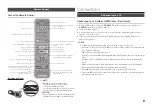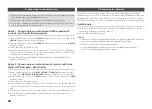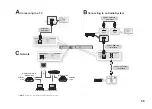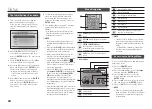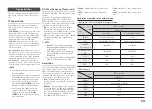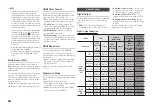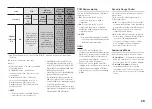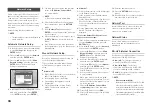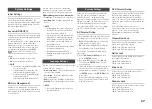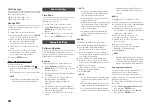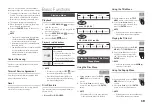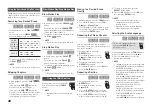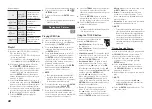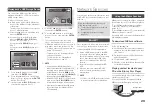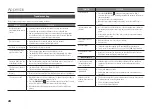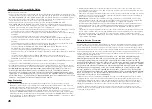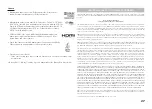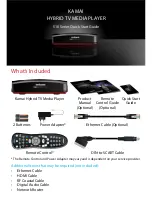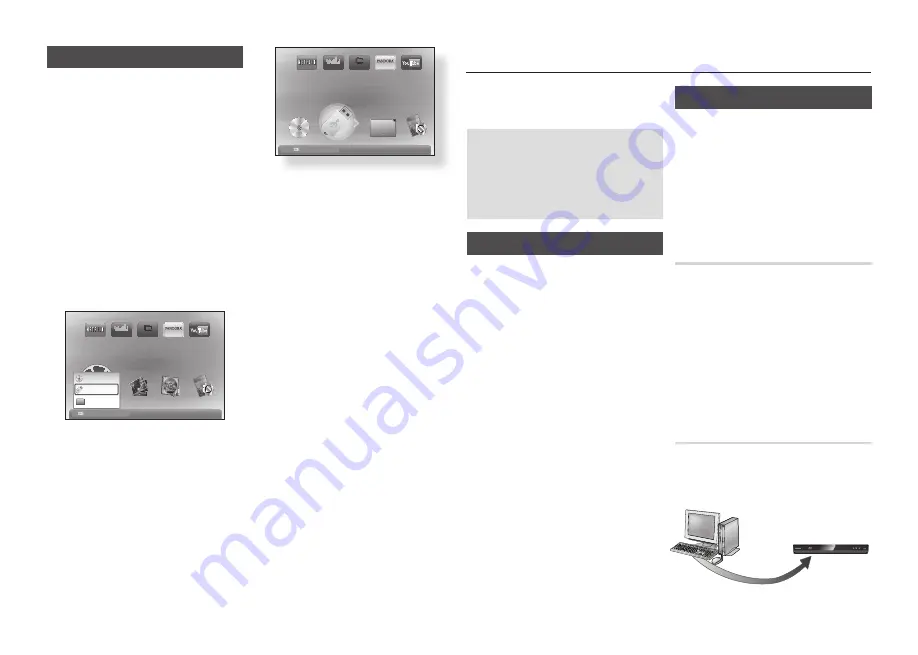
23
Playing back a USB Storage Device
You can use the USB connection to play
multimedia files (MP3, JPEG, etc) located on
a USB storage device.
Move to the
1.
Home menu.
In Stop mode, connect the USB storage
2.
device to the USB port on the front panel
of the player.
The message “Do you want to access the
device?” will be displayed.
Press the ◄► button to select
3.
yes
, then
press the
ENTER
button.
If you have a disc in the Blu-ray player,
4.
press the
RED (A)
or
BLUE (D)
button.
If you do not, go to Step 6.
If you pressed the
RED (A)
button, go to
Step 5.
If you pressed the
BLUE (D)
button, go to
Step 4
-1
.
YouTube
CinemaNow
PANDORA
i n t e r n e t r a d i o
HD Movies
No Disc
123
DLNA
123
a
Change Device
c
Safely Remove USB
d
View Devices
"
Enter
Press the ▲▼ buttons to select
5.
USB
,
then press the
ENTER
button.
Press the ◄► buttons to select Videos,
6.
Music or Photos, then press the
ENTER
button. Go to Step 7.
4
-1
.
If you pressed the
BLUE (D)
button, the
screen below appears. Go to 5
-1
.
YouTube
CinemaNow
PANDORA
i n t e r n e t r a d i o
HD Movies
123
123
d
Home
"
Enter
5
-1
.
Press the ◄► buttons to select
USB
,
then press the
ENTER
button.
6
-1
.
Press the ▲▼ buttons to select Videos,
Music or Photos, then press the
ENTER
button.
The controls and tools you use to play
7.
videos, music, and pictures located on a
USB device are identical to those you use to
play videos, music, and pictures on a disc:
- To play a video, see Playing a Video on
pages 19 through 21.
- To play music, see Listening to Music
on pages 21 and 22.
- To view photos, see Playing Back
Pictures on page 22 and 23.
✎
NOTE
You must remove the USB storage device
▪
safely (by performing the “Safely Remove USB”
function) in order to prevent possible damage
to the USB memory. Press the
MENU
button to
move to the Home menu, select the
YELLOW (C)
button, and then press the
ENTER
button.
When Audio-CD (CD-DA), MP3 or JPEG files are in
▪
stop mode, pressing the
FULL SCREEN
button on
the remote will not bring up a full screen picture.
If you i
▪
nsert a disc when playing a USB storage
device, the device mode changes to “DVD or
CD” automatically.
Network Services
You can enjoy various network services such
as BD-LIVE by connecting the player to your
network.
Read the following instructions before
using any network service.
Connecting the player to the network
1.
(pages 10 and 11).
Configuring the network settings
2.
(page 16).
BD-LIVE™
Once the player is connected to the network,
you can enjoy various movie-related service
contents using a BD-LIVE compliant disc.
Attach a USB memory stick to the USB
1.
jack on the side of the player, and then
check its remaining memory. The memory
device must have at least 1GB of free
space to accommodate the BD-LIVE
services.
Insert a Blu-ray Disc that supports BD-
2.
LIVE.
Select an item from various BD-LIVE
3.
service contents provided by the disc
manufacturer.
✎
NOTE
The way you use BD-LIVE and the provided contents
▪
may differ, depending on the disc manufacturer.
Using the AllShare Function
AllShare lets you play music, video, and photo
files located in your PC or NAS on the player.
To use AllShare with your player, you must
connect the player to your network (See
pages 10~11).
To use AllShare with your PC, you must install
AllShare software on your PC.
If you have NAS, you can use AllShare without
any additional software.
To download AllShare software
Go to Samsung.com
1.
Click Support, enter your player’s product
2.
number in the field that appears, and then
click Product.
On the next screen, click Get downloads
3.
under Downloads.
Click Software on the next page.
4.
Click the icon in the AllShare line under File
5.
to start the download.
Playing content located in your
PC on the Blu-ray Disc Player
You can view shared files of your computer to
your Blu-ray Disc Player.
You can get detailed instructions for using
AllShare from the Samsung.com web site.
AllShare Connection
Play back PC’s files
Blu-ray Disc Player

